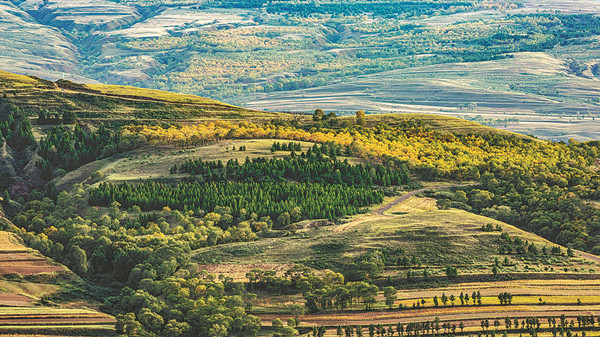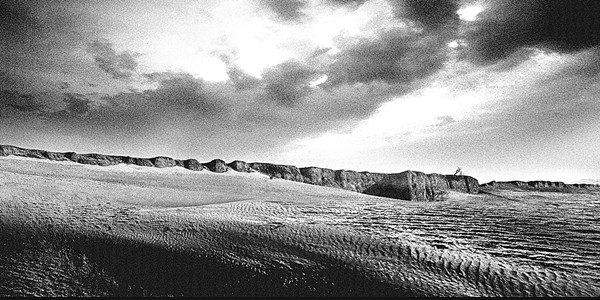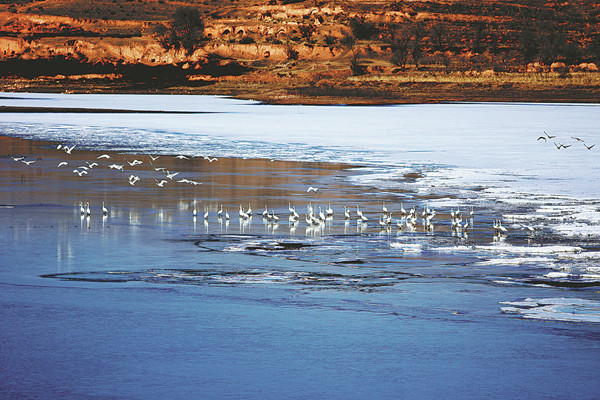Youyu still trying to win 'green relay race'
Updated: 2021-12-16

Forest and grassland cover the once barren mountains in Youyu county, Shanxi province. [Photo provided to China Daily]
Planting leads to prosperity for county in Shuozhou, Shanxi province that embroiled in long fight against desertification
With clusters of sea buckthorn fruit still hanging on branches and attracting birds from afar, the banks of the Cangtou River in Youyu county, Shuozhou, Shanxi province, is full of life even in early winter.
The river is the main source of water for an area of wetland that features a mixture of grassland, shrubs and forest. Known as the Cangtou River Ecological Belt, the wetland is like a shard of jasper embedded in the northeast edge of the dry loess plateau in northern China, at the point where it meets the desert of the Inner Mongolia autonomous region.
It is now a paradise for dozens of species, including roe deer, rabbits, Mongolian gazelles, foxes, badgers and more than 160 species of birds, including francolins and pheasants, among which 30 are considered rare.
Things were completely different in the past. In the late 1940s, the county's overall vegetation coverage rate was less than 0.3 percent, and desertified land accounted for a further 76.4 percent. Today, though, the vegetation coverage rate has risen to 56 percent.
Shuozhou records show that in the past, residents suffered from winds and sandstorms in the dry season and floods and landslides in the rainy season.
After nearly four months of field research, Zhang Ronghuai, Party chief of Youyu in 1949, proposed planting trees as a way to halt desertification.
The first aspen planted near the river ushered in a reforestation campaign that has lasted until today.

Desertified land covered more than 70 percent of the county in the 1940s. [Photo provided to China Daily]
At first, survival rates were low due to strong winds and water and soil loss.
Things began to change about 10 years later, when then Party Chief Ma Luyuan drew lessons from the desertification control experience in Gansu province. In line with Gansu's experience, he instructed residents to first plant grass and then sea buckthorns to halt the loss of water and topsoil, before planting trees.
Although county Party chiefs change every few years, reforestation has been pursued by subsequent generations of leadership. Locals call this their "green relay race", a competition against the constant threat of desertification.
Chang Lu, Party chief of Youyu from 1974 to 1982, played a crucial role in this race. It was under his leadership that the county began to improve the strains of trees planted-the second leap in its reforestation campaign after the decision to plant grass in the late 1950s.
By the time Chang died from overwork at his post at age 59, the county had already become an oasis thanks to more than 30 years of reforestation efforts. Its grain output was also increasing yearly.
In the final moments of his life, Chang told local officials that the "trees are the well the county's life hinges upon, and we must protect them".
Following the call of the local authorities, many farmers began to work toward the benefit of future generations, and the official campaign became a common cause in which everyone participated.
Yu Xiaolan, a woman now in her late 50s, was one of those participants. A self-taught tree-planting expert and farmer, Yu spent nearly 30 years working with local farmers, turning nearly 2,000 hectares of barren mountainside-places where "even hares would not crap" as the locals said-into woods, orchards and farmland. Sheep and goats are also grazed on the land she helped reclaim.
Yu's tree farm has become a park, and she has won a number of honorary titles, including that of National Model Worker, for her contributions to reforestation and poverty alleviation.
"Although it is very hard work, seeing barren mountains and valleys turn green really comforts me," Yu said.
She is the epitome of the difference residents have been able to make to the local environment and their own lives using only spades, pickaxes and buckets.

Water birds winter at the Cangtou River in Youyu. [Photo by Yue Feng/for China Daily]
Li Yunsheng, the former director of a driving school who quit his job to come back to his hometown 20 years ago, is another example of Youyu's reforestation models. Working with other farmers, he has turned about 933 hectares of barren mountains into woods.
"The trees are proof of my work, and seeing them grow makes me happy," he said.
To date, Li and his wife have raised some 100 cows in the mountains.
When asked how planting trees became a county tradition, Zhao Xiangdong, who was county head and Party chief in Youyu from 2001 to 2006, said that at first it was out of the need to survive and later because farmers benefited from the transformation brought about by the trees, as a healthy natural environment attracts tourists, investment and projects.
"Reforestation has become a self-propelled undertaking that guarantees the sustainable development of the county," he said.
Youyu now exports lamb to the Middle East and grain to South Korea, Japan and Southeast Asia. Beverage and food companies have invested to produce juice and vegetable and grain products.
The county also receives around 4 million tourists and photographers from home and abroad each year.
Experts say the fundamental changes to Youyu testified to the vitality of the green economy and the potential of an ecological civilization long before these concepts were entrenched as national development strategies. In that regard, Youyu has definitely blazed a trail.



